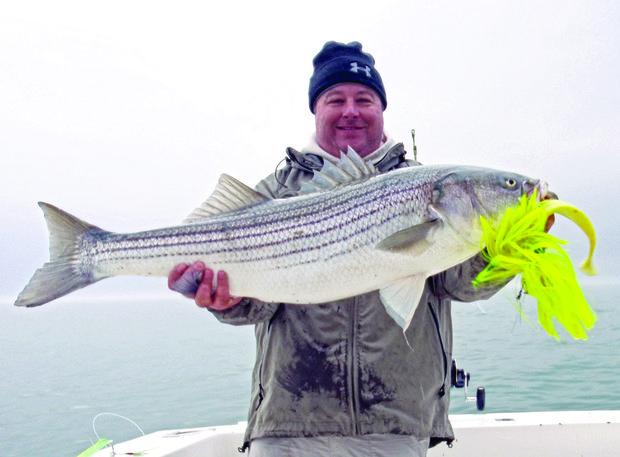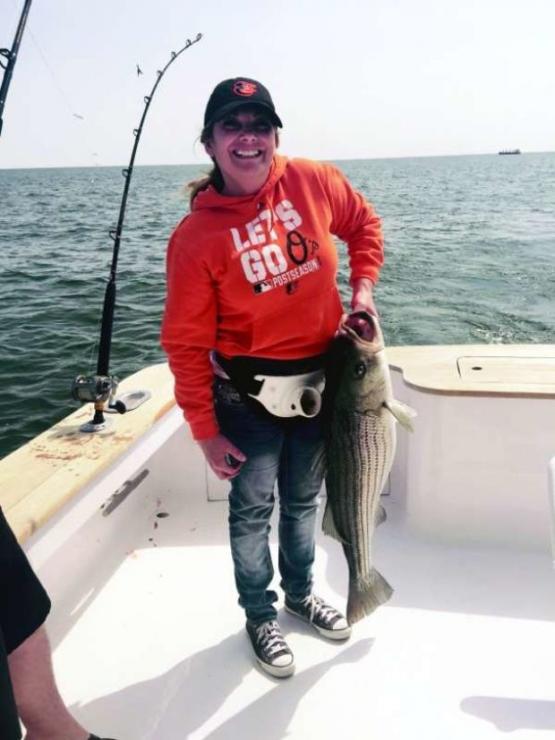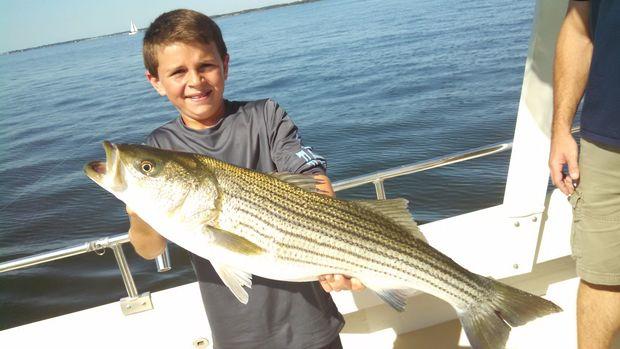Sometimes rockfish will hold close to the bottom in deep water, and even the most tempting offering presented close to the surface will go unmolested. This is especially true in the spring, when the fish are following channel edges on their way back to the ocean. There are a number of ways to present a trolled lure to deep dwelling rockfish, and here we look at a few.

Plugs
Deep-diving plugs are my personal favorite because they are easy to use and they catch fish. I started out with Mann’s Stretch 25s, and after all these years they are still my number one go-to lure. Stretch plugs currently come in several sizes and a multitude of colors. I use the 25 and 30 sizes in red and white, blue, green, and black back colors. The early models of Stretch 25s had three sets of light treble hooks. These may have been fine for freshwater fish, but big rockfish made short work of them. Mann’s received feedback from saltwater anglers and soon changed over to two sets of heavier trebles, and all has been well since then.
Rigging a Stretch is about as easy as it gets. Tie a six-foot length of 50-pound mono to the lure, put a perfection loop in the other end, and snap this to a ball-bearing swivel tied to the main line. Play the lure out 40 to 50 feet or more behind the boat, engage the reel, and put the rod in a holder. You should keep an eye on the rod tip for clues of how well the plug is working. The tip should vibrate with a steady frequency. If the vibration stops, something has fouled the plug. If the tip goes up and down and the plug jumps out of the water, you are trolling too fast. If the tip goes down and stays there, and line starts coming off the reel, you have either snagged bottom or you have a fish on.
As with most rockfish lures, the trolling speed is as slow as the boat will go. It is always a good idea to test the lure alongside the boat before letting it out. Run too fast and the plug will spin and jump out of the water. If the lure wants to swim to the right or left, bring it back and bend the eye in the opposite direction to correct the problem. A safety note: when cranking the plug back, slow down as it approaches the boat. I have seen these things come flying out of the water and barely miss the angler. Having one of those new and extra strong trebles attached to any part of your anatomy would not be a pleasant experience.

Planers
While a deep diving plug can get down by itself, lures (such as spoons and bucktails) need a little help. Enter the planer. This device is made of metal and will dive deep taking a light lure to the desired depth. I use Huntington planers and spoons for most of my deep diving fishing. They come in several sizes to imitate bait fish from small shiners to big bunker. When targeting large rockfish, I use either the four-and-a-half or three-and-a-half size spoon on a size four planer.
Rigging a spoon behind a planer is a bit more difficult than rigging a plug. I use 30 feet of 50-pound Hi Seas mono fishing line between the planer and the spoon. That’s right, 30 feet of leader. The long leader allows the spoon to work correctly. A ball bearing swivel must be used between the leader and the planer because spoons have a tendency to spin, and this will twist the leader into a terrible mess. I always tie up several leaders and spoons before leaving the dock, so if one does get tangled, I can cut it off and install a new set up.
As with the plugs, the trolling speed for planers and spoons is as slow as the boat will go. You want the spoon to imitate a wounded bunker, not a speeding barracuda. Signals from the rod tip are the same as when fishing with plugs. Getting a hooked fish into the boat can present problems. Once the planer gets to the rod tip, the reel’s work is done. On a charter boat, the mate must hand pull the rest of the leader in while netting the fish. When fishing with friends, the man on the rod should put it in a holder and pick up the net. Another man pulls in the leader, and the angler, now net man, does his best not to screw things up. In both situations the captain must keep the boat moving ahead at idle speed.
Another way to rig a planer is on a dumb leader. The planer is tied to a separate 100-pound leader that is then secured to the stern cleat, and the running line is attached via a release clip. When a fish hits, the release clip trips, and the angler can fight the fish unencumbered. At the end of the day, the planer must be tripped by dropping the rod tip and then raising it back up quickly. The dumb line must also be retrieved. Sometimes it will trip by pulling up some slack and letting it go quickly. At other times (read mostly) someone has to pull it in by hand. Hence the name dumb line.
Wire Line
There are two types of wire line: Monel and braided. Both work the same way. The usual setup is a three-way swivel secured to the end of the wire line with a ball bearing swivel. One eye of the swivel will have a lure, often a bucktail or a spoon, secured by a 30-foot leader of 50-pound Hi Seas mono line. The third eye on the three-way holds the sinker on three to five feet of 30-pound mono. This leader will be wrapped around the handle of the reel once the swivel is at the tip of the rod in order to keep the sinker from swinging around. The weight can vary from eight to over twenty ounces. Pulling a bucktail or spoon with wire line is pretty simple when fishing over smooth bottom. Let the sinker bounce off the bottom three times, engage the reel and put the rod in a holder. If you choose to use a parachute rig with wire line, be prepared to work the rod back and forth to get the most out of the lure.

MOJOS
MOJOs are nothing more than big bucktails tied with lots of hair in a parachute fashion. The large hook may be cast into the lead head or allowed to swing free. As a general rule, a large plastic shad or twister tail is attached to the hook. Since the lures are so heavy, no wire line or planer is needed. Some anglers will use braid while others stick with mono. MOJOs may be trolled as singles or in twos or threes. Some will have two large lead heads and three or four smaller, unweighted parachutes tied in between. Since most of these lures are privately made, there is no set pattern for construction. So there you have several methods to get a lure down deep. Use them this season and you will improve the number and size of the rockfish you catch.
by Eric Burnley